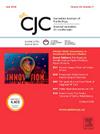系统“囚禁线”技术用于分叉临时支架术的益处。敞篷车子研究。
IF 5.8
2区 医学
Q1 CARDIAC & CARDIOVASCULAR SYSTEMS
引用次数: 0
摘要
背景:在冠状动脉分叉临时支架术中推荐侧支监禁钢丝(JW),但真正的益处尚不确定。我们的目标是评估在CABRIOLET注册表中使用JW技术的好处。方法:在CABRIOLET中,包括500例患者,我们比较了是否进行JW的主要复合终点最终SB血管造影结果差(TIMI流量b,血栓形成,残余狭窄bbb70%或额外SB支架植入)。在常规操作的基础上,我们还比较了系统JW策略:已知经常放置JW的操作人员(执行率为50%)和有条件策略:选择性JW操作(结果:251例患者(50.2%)进行了JW,基线临床和血管造影与非JW无显著差异。JW与较高的主要终点相关(15.1% vs 8.4%)。结论:在一项大型注册研究中,JW与无JW相比,与较差的最终SB血管造影结果相关。条件JW和系统JW两种方法的最终血管造影结果相似。本文章由计算机程序翻译,如有差异,请以英文原文为准。

Benefit of Systematic “Jailed Wire” Technique for Bifurcation Provisional Stenting. A CABRIOLET Substudy
Background
Jailed wire (JW) in the side branch (SB) is recommended during coronary bifurcation provisional stenting, but there is uncertainty about the real benefit. Our objective was to evaluate the benefit of a JW technique in the Coronary Artery Bifurcation Revascularization Without kIssing ballOon infLation by rEpoT (CABRIOLET) registry.
Methods
In CABRIOLET, which included 500 patients, we compared the primary composite end point of a poor final SB angiographic result (of Thrombolysis in Myocardial Infarction (TIMI) flow < III, dissection grade > B, thrombosis, residual stenosis > 70%, or additional SB stenting) whether JW was performed or not. On the basis of the usual operator practice, we also compared a systematic JW strategy: operators known to place JW frequently (> 75% performed), to a conditional strategy: selective JW practices (< 20% of JW).
Results
JW was performed in 251 patients (50.2%), without significant baseline clinical and angiographic differences compared with those who received no JW. JW was associated with higher primary end point (15.1% vs 8.4%; P < 0.05), and increased fluoroscopy time and contrast volume (15.9 ± 7.3 minutes and 181 ± 62 mL vs 13.3 ± 6.5 minutes and 161 ± 74 mL; P < 0.05). JW was performed in 12.1% of patients (26 of 214) in the conditional JW group and 78.7% (225 of 286) in systematic group. The primary end point was similar in both strategies (11.2% and 12.2%; P = 0.78), although with greater fluoroscopy time and contrast volume for systematic JW (180 ± 57 mL and 15.3 ± 7.5 minutes vs 162 ± 79 mL and 13.7 ± 6.1 minutes; P < 0.05). There was no difference in 1-year major adverse cardiovascular events depending on whether JW was performed or not and between conditional or systematic strategies.
Conclusions
In a large registry, JW was associated with poorer final SB angiographic results than no JW. Final SB angiographic results were similar between conditional or systematic JW strategies.
求助全文
通过发布文献求助,成功后即可免费获取论文全文。
去求助
来源期刊

Canadian Journal of Cardiology
医学-心血管系统
CiteScore
9.20
自引率
8.10%
发文量
546
审稿时长
32 days
期刊介绍:
The Canadian Journal of Cardiology (CJC) is the official journal of the Canadian Cardiovascular Society (CCS). The CJC is a vehicle for the international dissemination of new knowledge in cardiology and cardiovascular science, particularly serving as the major venue for Canadian cardiovascular medicine.
 求助内容:
求助内容: 应助结果提醒方式:
应助结果提醒方式:


